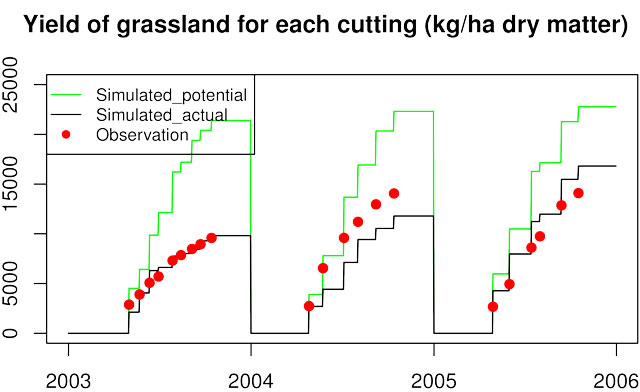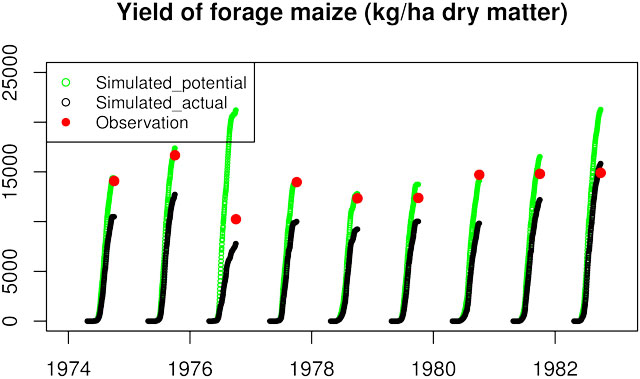Knowledge journal / Edition 2 / 2015
Effects of water
management
on crop yield
A new instrument for the quantification of agricultural crop yield reduction due to too wet, too dry or too salty conditions: what kind of instrument should that be? And could such an instrument be usable for the calculation of effects of climate scenarios? WaterVision Agriculture should be the answer to these questions.
Plant growth is determined by the availability of solar radiation, CO2, water, oxygen, salt and soil nutrients. To achieve maximal growth plants always try to take sufficient water and oxygen from the soil. When the availability of water (too dry) or oxygen (too wet) in the root zone is insufficient, plants will undergo either drought or oxygen stress. When the salt concentration in soil water is too high, the water uptake will decrease.
The climate is changing and weather conditions are becoming more capricious. As a consequence the current instruments are no longer sufficient for the determination of the direct effect of hydrological conditions in the root zone on agricultural yield. Different groups of users, like water boards, provinces, drinking water companies and the Department of Waterways and Public Works are therefore demanding a climate-proof instrument that can determine crop yield effects as a result of drought, too wet or too saline conditions.
WaterVision Agriculture should become that new instrument. An instrument that can simulate soil hydrology and crop growth on the basis of different weather conditions and future climate. Based on currently available knowledge in this field and user-friendly. For agriculture it is important that the effects are expressed in actual crop yield changes and farm economic interpretation.
Meanwhile the project WaterVision Agriculture has already supplied a few products. In this method the agro hydrological simulation model SWAP and the crop growth simulation model WOFOST together form the core of the calculation of crop yields as a function of soil moisture conditions. Based on these specialist models practically applicable functions are being assessed. This article addresses the usability of the connected model instruments and offers a view to potential applications. The ultimate goal is replacing the current methods for calculation of agricultural effect of hydrological changes by one new method.
On the one hand crop yields are affected by interference in the water balance and its effect on crop transpiration (the so-called direct effects) and on the other hand due to indirect effects, partly as a result of land management.
Such indirect effects are for instance the result of workability problems, decrease in crop quality or damage to the soil structure. This article focusses on the first category; the indirect effects are dealt with further in the investigation.
 Figure 1: Stream scheme of crop growth processes in WOFOST
Figure 1: Stream scheme of crop growth processes in WOFOST
Background
Since long Dutch water management has been familiar with different methods for quantifying impact of hydrology on agricultural yield. Water boards use the so-called HELP-tables to read out the amount of loss of revenue based on information on soil profile, groundwater level and crop type. These HELP-tables have been developed to determine the effects of water management measures on the yield of agricultural crops in land development projects, and show annual average yield reduction over many years.
For the calculation of disappointing revenue as a result of permanent ground water extraction the Advice Committee Damage Ground Water (ACSG) uses the TCGB-tables. These tables resemble the HELP-tables, but give a more detailed insight in loss of revenue and only concern grassland on sandy soil.
These frequently used tables are outdated. The determination of drought effects with the HELP tables is based on outdated meteorological data and both too wet and too dry conditions are based on experiences from past agricultural practice. The tables only provide an image of the annual average damages, where information on the variety of damage in time as a result of changing weather conditions is needed. Besides effects of saline conditions are not considered at all.
The HELP- and TCGB-tables are therefore unsuitable for application in both the current and future climate. There is a need for an improved agricultural effect module, already contended in the knowledge program Delta proof of the Foundation for Applied Water Research (STOWA) and in a formerly executed inventory of the need to replace the HELP-tables.
So under auspices of STOWA a wide acknowledgement of the development of a method for determining agricultural effect as a result of agro hydrological circumstances has been realised, based on the agro hydrological model SWAP and the growth simulation model WOFOST. This method can calculate for climate scenarios and obtain climate proof damage relations as well.
Approach and results
The project WaterVision Agriculture covers different phases.
Phase 1 worked towards an operational instrument on the basis of SWAP to calculate damage by drought, too wet and too saline conditions. This was done for grassland, silage maize and potato and the relation with crop transpiration.
Phase 2, executed in 2013 and 2014 resulted in a connection of the agro hydrological model SWAP with the crop simulation model WOFOST to an operational and tested simulation model for grass, potato and silage maize, that can calculate crop transpiration reduction as well as calculate crop yield reduction.

 Figure 2: Example calculation of SWAP-WOFOST for grassland (field experiment with multiple cuts in Zegveld) and silage maize (field experiment in Cranendonck). In both figures the observed yield is presented with red dots and two lines for respectively calculated potential and actual yield
Figure 2: Example calculation of SWAP-WOFOST for grassland (field experiment with multiple cuts in Zegveld) and silage maize (field experiment in Cranendonck). In both figures the observed yield is presented with red dots and two lines for respectively calculated potential and actual yield
The SWAP (Soil-Water-Atmosphere-Plant) model is a widely used model, initiated for the determination of the actual evapotranspiration as a function of meteorological data, combined with crop and soil data. The model simulates for the so-called top system, the unsaturated and saturated upper part of the soil profile, where the interaction between ground and surface water is important. The model SWAP calculates the water transport, dissolved substances and soil temperature.
The WOFOST (WOrld FOod STudies) model calculates the potential crop yield as a function of the CO2-level, solar radiation, temperature and crop characteristics. Subsequently the water availability determines the water-limited crop production when all other factors (nutrients for instance) are optimally available. The basis for the calculation is leaf area and incoming solar radiation. Subsequently the amount of light and CO2 that is intercepted and potentially converted to photosynthesis is calculated. Then the actual photosynthesis is calculated by the reduction of the potential photosynthesis for limited availability of water, or oxygen or too high concentrations of salt.
This speaks volumes about crop growth. Part of the energy that becomes available through photosynthesis is used for maintenance respiration and growth respiration. The residual part is converted to dry matter, that depending on temperature and the development stage of the crop is divided over the different parts of the crop: roots, stems, leaves and storage organs.
The SWAP model uses a so-called static crop with the same assumption on crop development and unchanging values for the leaf area development and roots every year. The dynamic growth of crops can be taken into account in the SWAP-WOFOST connection. This results in a more realistic crop development, varying annually due to meteorology and hydrology. For the hydrological calculations of SWAP more realistic crop dynamics at the top layer of the soil profile is created and also a realistic dynamic development of rooting depth. The connection SWAP-WOFOST supplies a direct calculation of agricultural yield.
With SWAP-WOFOST the influence of extreme weather conditions, such as heavy rainfall intensity, long lasting drought, CO2 increase and fluctuating temperatures are considered when calculating climate scenarios. Different photosynthesis systems of crops can be taken into account as well.
Figure 2 shows an example of the type of calculations that can be made with SWAP-WOFOST. The graphics also show the similarities with measured crop yield.
From model to practical tool
Application of the SWAP-WOFOST model requires specialist knowledge, whereas the demand is to get a simple user-friendly method for the quantification of agricultural yield effects. Based on the detailed SWAP-WOFOST-simulations however, simple relations between ground water characteristics and yield can be derived, applicable without further interference of models. Such relations facilitate the translation of water management conditions to yields because SWAP-WOFOST-simulations are no longer needed for the application of those relations.
Then, groundwater levels, generally measured or modelled, can be translated to yield through simple relations. Distraction of these relations saves a large amount of calculations for the user. The principle for deriving these ‘meta-relations’ has been formerly executed as well: HELP-tables and TCGB-tables are in fact examples of simple relations. At this moment we are working on those simple relations for grass and maize silage.
WaterVision Agriculture enables use of the connected SWAP-WOFOST for:
- Calculating crop yields as a function of hydrology and so generating insight in variation between and also within years, under extreme conditions, of direct effects on crop yield as a result of drought, salt and wet soil water conditions for grassland, silage maize and potato for actual weather and climate projections.
- A ‘customized’ calculation that uses available field data for questions on ecological coherence or level management.
The connection of SWAP and WOFOST that was realised within WaterVision Agriculture for estimating crop yields has supplied a reproducible and verifiable system. In other words: a valuable instrument for the objective determination of crop yield effects and directing measures that aim at water balance interference.
Mirjam Hack-ten Broeke
(Alterra Wageningen UR)
Ruud Bartholomeus
(KWR Watercycle Research Institute)
Joop Kroes
(Alterra Wageningen UR)
Jos van Dam
(Wageningen Universiteit)
Jan van Bakel
(De Bakelse Stroom)
Summary
Different user groups, such as water boards, provinces, drinking water companies and the Department of Waterways and Public Works are in need of a new instrument that can determine crop yield in relation to drought, too wet or saline conditions. Such an instrument is being developed in cooperation with different parties (under auspices of the Foundation for Apllied Water Research (STOWA) regarding the project WaterVision Agriculture.
It is important that the instrument is able to simulate for different weather conditions and is suitable for climate scenarios as well.
Meanwhile, the project has delivered some products, like the combination of the agro hydrological model SWAP and the crop simulation model WOFOST. These enable calculating crop yield as function of hydrology, getting insight in variation between and also within years, under extreme conditions, of direct effects on crop yield as a result of drought, salt and too wet conditions for grassland, silage maize and potato for actual weather and climate scenarios. This instrument, of which a user-friendly variety is being developed, is a major leap forward.
Auteurs

Mirjam Hack-ten Broeke
(Alterra Wageningen UR)

Ruud Bartholomeus
(KWR Watercycle Research Institute)

Joop Kroes
(Alterra Wageningen UR)

Jos van Dam
(Wageningen Universiteit)

Jan van Bakel
(De Bakelse Stroom)







